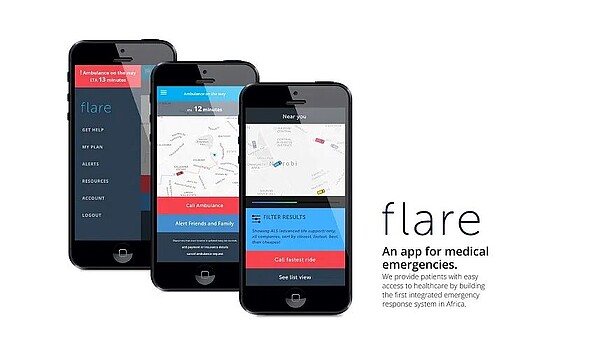

How do you solve a problem like the availability of emergency services – such as ambulances – in emerging markets? At least one attempt at answering the question of ensuring optimal availability and use of ambulance services is being addressed in Kenya by a company called Flare, which is benefitting from continuing research carried out by faculty members at RSM.
How do you solve a problem like the availability of emergency services – such as ambulances – in emerging markets? At least one attempt at answering the question of ensuring optimal availability and use of ambulance services is being addressed in Kenya by a company called Flare, which is benefitting from continuing research carried out by faculty members at RSM.
Flare built an end-to-end emergency response system in Kenya to tackle the problems of slow and difficult-to-reach services, by aggregating existing ambulance capacity on their digital emergency response platform, and running an emergency dispatch centre. Headquartered in Nairobi, it has ambulances throughout the country and is currently working with RSM researchers on expanding its operational and commercial model to the Kakamega region of the country. It is also looking to expand beyond Kenya and across the region where an estimated 95 per cent of the continent also lacks a centralised emergency medical services (EMS) system.
The most common emergency service requirements in Nairobi arise from road traffic accidents, reflecting the city's economic growth and industrialisation. Beyond Nairobi, the largest share of emergency calls is related to complications related to childbirth.
It is relatively easy to compare the service Flare offers to existing consumer-based vehicle-sharing platforms such as Uber. But the very citation of Uber as analogous prompts many challenging questions and delivers equally challenging answers, not least is that waiting an hour for an Uber might represent a minor inconvenience, but waiting an hour for an ambulance could mean the difference between life and death.


The relationship between Flare and RSM grew organically over the last few years. Flare enthusiastically embraced RSM’s early findings on the relationship between the availability of ambulances, their geographical spread, and the response times to emergency calls. This confirmed Flare’s observation that the reason for the unacceptably long response times was not a shortage of ambulances, but the lack of co-ordination in a system reliant upon an excessive number of ambulance service providers and an equally excessive number of emergency phone numbers.
The RSM research identified that the main differences between ambulance platforms in emerging markets and traditional ambulance services lie in the quantity and quality of information about the availability of ambulances and the capability to relocate them. In traditional ambulance services, it is common to use the information about ambulance availability and location to relocate ambulances to address gaps in the coverage. In contrast, ambulance platforms in emerging markets often lack the knowledge about the availability of all ambulances and their locations, and typically do not fully control these ambulances. These features increase the complexity of the optimal system operation.
The thinking behind the creation of the Flare system is thought-provoking in itself. “We did not want to create a US-style system involving payment at the time of emergency,” says Caitlin Dolkart, a co-founder and CEO of Flare. “There is no doubt that this can work exceptionally well in terms of the arrival of an ambulance on the emergency scene, but we don't believe that making such decisions in such a fraught situation will necessarily make the best healthcare decisions. We wanted to be accessible, affordable and not dependent upon triggering payment on the calling of an ambulance. In an emergency, you need to receive care in less than an hour. This is called the ‘golden hour’, giving victims of accidents the greatest chance of surviving an emergency. In Nairobi, it used to take 162 minutes, nearly three times what it should.”
Caitlin explains that the underlying reason for this disparity between the ideal and the reality is the fragmentation of provision. In the days before the Flare platform, there was no single three-digit emergency telephone number for ambulances in Kenya that actually worked and people often had to call hundreds of different numbers in an emergency, making it a completely inefficient system.
Flare's arrival on the scene has already brought a significant improvement. “We created our service for the countless people who could not access emergency help. All of the ambulance providers and partners we work with benefit from our centralisation of the services so that they are used more often.”
Flare does not own a single ambulance but assesses all aspiring providers to ensure they have the appropriate quality of services, personnel and equipment. “Thanks to our platform, thousands of ambulances that might be sitting in a parking lot doing nothing but waiting are now available to respond,” she continues. “All are fitted with GPS and smartphones; we know exactly where they are and their capabilities. We run the equivalent of a 999, 112 or 911 service and control the whole process from start to finish.
We receive your call, provide emergency triage over the phone, and deliver what care and reassurance we can on the phone all while we’re behind the scenes sending out an ambulance. Finally, we co-ordinate which hospital the patient goes to, which is very important in an emergency as most facilities don’t have the services that a patient needs.”
At the point of arrival at the designated hospital, Flare ensures the patient is admitted and seen by the right healthcare team before finally finishing the call. “We have now handled more than 15,000 dispatches nationwide and the average response time, from call to ambulance arrival, is now 15 minutes,” she says.
“In the first year of operation we brought the waiting time down from 162 minutes to 69 minutes. That means people who require emergency care can call us quickly and easily, we dispatch an ambulance, the ambulance arrives on scene and patients find themselves in hospital in 69 minutes. Our ambition is to not stop, and we won't stop until the majority of the world has access to emergency services through platforms and services such as ours.”
This obviously involves costs, to finance the machinery and people required to make the system work. “Ambulances tend to be needed instantly, and they are expensive machines,” adds Stef Lemmens, assistant professor with RSM’s department of Technology and Operations Management. “But their provision is also a business model, requiring continuing decisions about fleet acquisition, organisation and deployment. How many ambulances will you need? What kind will they be in terms of purpose and specification? Where will they be located? How will they and their crews be managed? Will they roam around their area of operation? Will they be based at their home hospital? Will they find an alternative parking location? Will they be available 24/7? What will the pricing model be? Will it be based on a subscription fee? Or will it be based on actual hard usage?”
“Many of these questions have been answered for the traditional EMS system we see in the developed world where ambulances are owned and controlled by the provider,” says Pieter van den Berg, Associate Professor of Transportation and Logistics at RSM. “However, the answers might be very different in the case of Flare as they have only limited control over the fleet. This lack of control gives rise to interesting research questions.”
The initial results, based on analysis of the optimal distribution of a fully flexible, fully available fleet of 10 ambulances, show that these 10 ambulances would be able to serve 93 per cent of Flare’s demand in Nairobi within 15 minutes. To illustrate the novel role of ambulance availability in this problem, a fleet of double the size that is only available 50 per cent of the time would, with the same expected number of available ambulances, only serve 80.3 per cent of the same requests within 15 minutes.
In conclusion, the strength of academic interest taken in the subject by RSM’s Stef Lemmens and Pieter van den Berg, and the working relationship that has grown with Flare in recent years, will drive further mutually beneficial research. They and Caitlin Dolkart continue to work on this project together with other academic contributors: Andre Calmon of the Georgia Institute of Technology, Andreas Gernert of Kühne Logistics University, and Gonzalo Romero of the University of Toronto.
While the researchers are targeting eventual publication of a formal academic paper, Flare has already benefitted operationally and commercially, and will benefit further in the future from their ongoing endeavours. For the record, Flare operates a subscription fee model which guarantees a certain level of revenue in return for committing to fulfil the obligations that they assume.
“Our subscription list price is 4,000 Kenyan shillings (approximately €33) a year,” explains Caitlin, “but that can be reduced to a much lower level through participation in group membership or insurance-related risk-pooling membership.”
A final distinguishing feature between Flare and other platforms is the deliberate placing of humans at the heart of the system. As Caitlin Dolkart says: “You don't want to ring for an ambulance in an emergency and hear a robot saying ‘press number one if you are having a heart attack,’ do you?”


Science Communication and Media Officer
Rotterdam School of Management, Erasmus University (RSM) is one of Europe’s top-ranked business schools. RSM provides ground-breaking research and education furthering excellence in all aspects of management and is based in the international port city of Rotterdam – a vital nexus of business, logistics and trade. RSM’s primary focus is on developing business leaders with international careers who can become a force for positive change by carrying their innovative mindset into a sustainable future. Our first-class range of bachelor, master, MBA, PhD and executive programmes encourage them to become to become critical, creative, caring and collaborative thinkers and doers.
